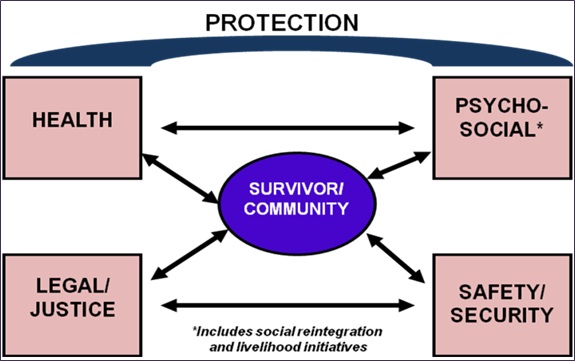- Programming experiences from the field have revealed that no single sector or agency can adequately address all elements of VAWG response. The multi-sectoral model calls for holistic inter-organizational and inter-agency efforts that promote participation of people of concern, interdisciplinary and inter-organizational cooperation, and collaboration and coordination across key sectors, including (but not limited to) health, psychosocial, legal/justice and security. Sectors are comprised of all the institutions, agencies, individuals and resources that are targeted towards a specific goal (e.g., the health sector includes the Ministry of Health, hospitals, health care centres, health care providers, health care administrators, health care training institutions, health supplies, etc.). For discussion of the multi-sectoral model, see UNHCR, 2001. Prevention and Response to SGBV in Refugee Situations: Interagency Lessons Learned Conference Proceedings, www.rhrc.org, and the more recent UNHCR, 2003. Interagency Guidelines for the Prevention of and Response to Sexual and Gender-based Violence Against Refugees, Returnees, and Internally Displaced Persons, www.rhrc.org.

- The multi-sectoral model explicitly highlights responsibilities unique to each sector (for more information about the responsibilities of each sector, see Section VII: Implementing Response Programming):
- The health sector should train providers across a wide variety of health services to recognize and address violence against women and girls; ensure same sex interviewers for individuals who have been exposed to violence; respond to the immediate health and psychological needs of the woman or girl who has been exposed; institute protocols for treatment, referral and data collection and documentation that guarantee confidentiality; provide violence-related treatment free of cost; and be prepared to provide forensic evidence and testimony in court when authorized by the individual.
- The psychosocial sector should be able to provide ongoing psychological assistance, which requires the training and on-going supervision of psychologists, social workers and community services workers, and facilitate referrals for other services. Education and income-generation projects are also considered under the umbrella of psychosocial programming within this multi-sectoral model. Education systems should ensure curricula on “safe touch,” healthy relationships, and basic human rights; institute codes of conduct for all teachers as well as training on identifying risk signs among children; and provide school-based services for children who have been exposed to violence. Income-generating projects should not only promote women’s economic self-sufficiency, but also monitor for domestic violence risks and integrate human rights education into project activities.
- The legal/justice sector should be able to provide free or low-cost legal counselling, representation and other court support to women and girls who have been exposed to violence; review and revise laws that reinforce violence against women and girls; enforce laws that protect women and girls and punish perpetrators; monitor court cases and judicial processes; provide orders of protection and other legal safety mechanisms for survivors; and monitor perpetrators’ compliance with court-ordered rehabilitation (e.g., batterer programs).
- Within the security sector police, military and other security personnel should be educated about violence against women and girls and be trained on how to appropriately intervene in cases of violence against women and girls. Police should have private rooms to ensure confidentiality and safety of survivors reporting a victimization; ensure same sex interviewers; institute protocols for referrals to other sectors; collect standardized and disaggregated data on incidents; and create specialized units to address violence against women and girls.
- Some of the crosscutting functions of each of the sectors include engagement and education of the community, safe and confidential data collection, and monitoring and evaluation. Another critical component is inter- and intra-sectoral coordination, including the creation and monitoring of reporting and referral networks, information sharing, and participation in regular meetings with representatives from the various sectors. (See information on SOPs.)
- A key principle underlying the multi-sectoral approach is that the rights and needs of survivors are pre-eminent, in terms of access to respectful and supportive services, guarantees of confidentiality and safety and the ability to determine the course of action for addressing the incident.
- Another essential element of the multi-sectoral approach is close cooperation with local women’s groups. Women and girls must be included from the beginning of program design and maintain an active role throughout program monitoring, evaluation and on-going program development. (See guiding principles for more information.)
Additional Tools
For training on the multi-sectoral approach, see Vann, B. 2004. Training Manual Facilitator’s Guide, Multi-sectoral and Interagency Prevention and Response to Gender-based Violence in Populations Affected by Armed Conflict, also available in english.
Additional Resources
For general information on establishing GBV programming in humanitarian contexts, see:
ICRC. 2004. Addressing the Needs of Women Affected by Armed Conflict: An ICRC Guidance Document.
Steinberg, D. 2010. “Working Paper on Preventing and Responding to Sexual Violence against Women Displaced by Conflict”.
Women’s Commission for Refugee Women and Children. 2006. “Displaced Women and Girls at Risk: Risk Factors, Protection Solutions and Resource Tools”.
USAID, 2007. Women and Conflict. An Introductory Guide for Programming.
UNFPA, 2007. Challenges and Good Practices in Support of Women in Conflict and Post-Conflict Situations
